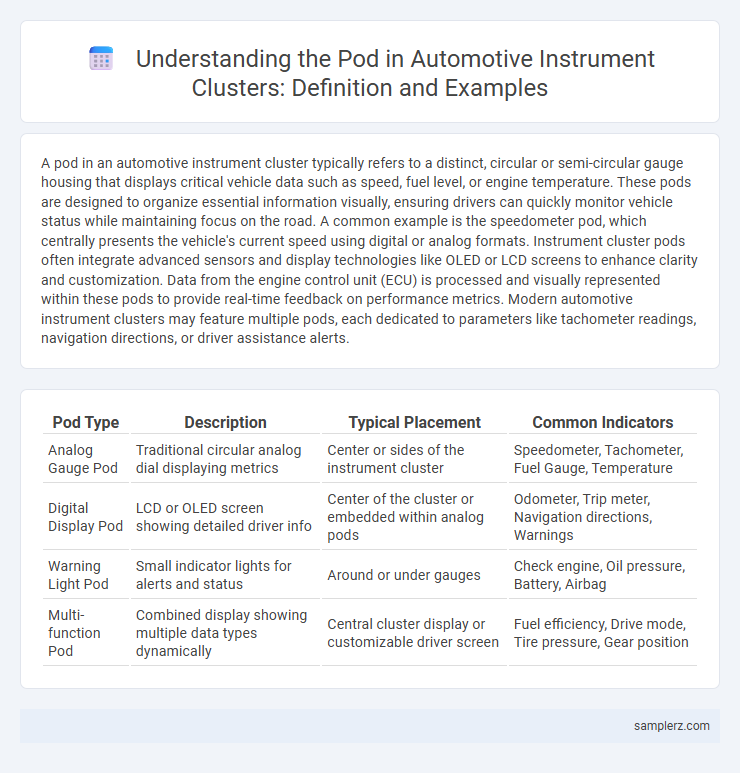A pod in an automotive instrument cluster typically refers to a distinct, circular or semi-circular gauge housing that displays critical vehicle data such as speed, fuel level, or engine temperature. These pods are designed to organize essential information visually, ensuring drivers can quickly monitor vehicle status while maintaining focus on the road. A common example is the speedometer pod, which centrally presents the vehicle's current speed using digital or analog formats. Instrument cluster pods often integrate advanced sensors and display technologies like OLED or LCD screens to enhance clarity and customization. Data from the engine control unit (ECU) is processed and visually represented within these pods to provide real-time feedback on performance metrics. Modern automotive instrument clusters may feature multiple pods, each dedicated to parameters like tachometer readings, navigation directions, or driver assistance alerts.
Table of Comparison
| Pod Type | Description | Typical Placement | Common Indicators |
|---|---|---|---|
| Analog Gauge Pod | Traditional circular analog dial displaying metrics | Center or sides of the instrument cluster | Speedometer, Tachometer, Fuel Gauge, Temperature |
| Digital Display Pod | LCD or OLED screen showing detailed driver info | Center of the cluster or embedded within analog pods | Odometer, Trip meter, Navigation directions, Warnings |
| Warning Light Pod | Small indicator lights for alerts and status | Around or under gauges | Check engine, Oil pressure, Battery, Airbag |
| Multi-function Pod | Combined display showing multiple data types dynamically | Central cluster display or customizable driver screen | Fuel efficiency, Drive mode, Tire pressure, Gear position |
Introduction to Instrument Cluster Pods in Automotives
Instrument cluster pods in automotive design serve as modular housings for critical vehicle information displays, integrating speedometers, tachometers, and fuel gauges into a cohesive visual interface. These pods enhance driver awareness by providing clear, customizable readouts with advanced digital or analog instrumentation. Incorporating pods allows manufacturers to innovate ergonomic layouts, improve safety features, and streamline dashboard aesthetics for diverse vehicle models.
Definition and Function of a Pod in Instrument Clusters
A pod in an automotive instrument cluster is a dedicated housing or module that contains specific gauges or displays, such as a speedometer, tachometer, or fuel gauge. Its primary function is to organize and present critical driving information clearly and accessibly to the driver, enhancing situational awareness. Modern pods often integrate digital screens or LED indicators to provide customizable and real-time data visualization within the dashboard.
Types of Pods Used in Modern Instrument Clusters
Modern instrument clusters utilize various types of pods, including digital LCD pods, analog pods, and hybrid pods that combine both digital and analog elements for enhanced readability and customization. Digital LCD pods offer dynamic display capabilities such as customizable gauges and real-time vehicle information, while analog pods provide traditional, easy-to-read circular gauges for speed and RPM. Hybrid pods integrate digital screens within analog frames, delivering a balance of classic aesthetics and advanced functionality commonly found in premium automotive models.
Speedometer Pod Example and Its Key Features
The speedometer pod in an automotive instrument cluster provides real-time vehicle speed readings through an analog dial or digital display, enhancing driver awareness. Key features include high visibility under various lighting conditions, customizable interface options, and integration with advanced driver-assistance systems (ADAS) for safety alerts. Precision sensors and responsive calibration ensure accurate speed measurement, contributing to overall driving performance and compliance with traffic regulations.
Tachometer Pod: Design and Automotive Applications
The Tachometer Pod in automotive instrument clusters features a precision-engineered dial displaying engine RPM, enabling drivers to optimize performance and fuel efficiency. Its ergonomic design integrates advanced LED backlighting and crisp analog or digital displays for real-time engine speed feedback. Automotive applications include performance vehicles, hybrid systems, and commercial trucks, where accurate tachometric data ensures efficient engine management and safety compliance.
Fuel Gauge Pod: Integration and Display Technology
The Fuel Gauge Pod in automotive instrument clusters features advanced integration with digital display technology for precise fuel level monitoring. Utilizing OLED or LCD screens, it offers real-time, high-resolution readouts combined with sensor data to enhance driver awareness and fuel management. This integration supports customizable interfaces that adapt to vehicle models, improving ergonomics and driving safety.
Temperature Gauge Pod: Importance in Vehicle Monitoring
The Temperature Gauge Pod in an instrument cluster provides real-time monitoring of the engine coolant temperature, crucial for preventing overheating and ensuring optimal engine performance. Accurate temperature readings help drivers detect potential issues early, minimizing the risk of engine damage and costly repairs. Integrating this pod with advanced sensors enhances vehicle safety and longevity by maintaining proper thermal management.
Digital vs. Analog Pods in Instrument Clusters
Digital pods in instrument clusters offer customizable displays, enabling drivers to access real-time data such as speed, fuel levels, and navigation with enhanced clarity and precision. Analog pods provide traditional dial-based readouts, favored for their simplicity and immediate visual recognition, often using mechanical gauges like tachometers and speedometers. Modern automotive design increasingly integrates digital pods due to their adaptability and ability to present multifunctional information within compact instrument cluster layouts.
Customization Options for Instrument Cluster Pods
Instrument cluster pods in modern vehicles offer extensive customization options including configurable gauge layouts, digital displays, and color schemes to match driver preferences. Advanced pods enable integration of real-time data such as navigation prompts, performance metrics, and safety alerts, enhancing the driving experience. Automakers increasingly utilize OLED and LCD technology within these pods to provide sharper visuals and adaptive brightness for varied lighting conditions.
Future Trends in Automotive Instrument Cluster Pod Design
Future trends in automotive instrument cluster pod design emphasize digital integration with customizable OLED and AMOLED displays, enhancing driver interaction through augmented reality and seamless connectivity with smart devices. Advanced sensor fusion technology enables real-time data visualization, improving safety by providing intuitive alerts and adaptive information based on driving conditions. The shift towards modular, lightweight materials supports more flexible and ergonomic cluster configurations, aligning with electric and autonomous vehicle innovations.

example of pod in instrument cluster Infographic
 samplerz.com
samplerz.com